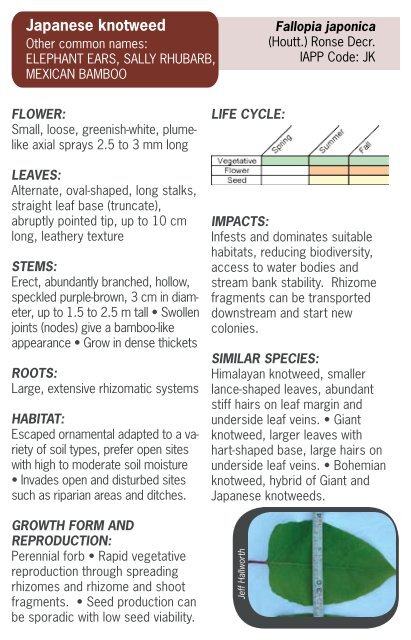Invasive Plants Identification Field Guide - Jun - Ministry of Forests
Invasive Plants Identification Field Guide - Jun - Ministry of Forests
Invasive Plants Identification Field Guide - Jun - Ministry of Forests
Create successful ePaper yourself
Turn your PDF publications into a flip-book with our unique Google optimized e-Paper software.
Japanese knotweed<br />
Other common names:<br />
ElEPhant EaRS, Sally RhubaRb,<br />
MExIcan baMboo<br />
Flower:<br />
Small, loose, greenish-white, plumelike<br />
axial sprays 2.5 to 3 mm long<br />
leaves:<br />
Alternate, oval-shaped, long stalks,<br />
straight leaf base (truncate),<br />
abruptly pointed tip, up to 10 cm<br />
long, leathery texture<br />
stems:<br />
Erect, abundantly branched, hollow,<br />
speckled purple-brown, 3 cm in diameter,<br />
up to 1.5 to 2.5 m tall • Swollen<br />
joints (nodes) give a bamboo-like<br />
appearance • Grow in dense thickets<br />
roots:<br />
Large, extensive rhizomatic systems<br />
Habitat:<br />
Escaped ornamental adapted to a variety<br />
<strong>of</strong> soil types, prefer open sites<br />
with high to moderate soil moisture<br />
• Invades open and disturbed sites<br />
such as riparian areas and ditches.<br />
GrowtH Form and<br />
reproduction:<br />
Perennial forb • Rapid vegetative<br />
reproduction through spreading<br />
rhizomes and rhizome and shoot<br />
fragments. • Seed production can<br />
be sporadic with low seed viability.<br />
liFe cycle:<br />
Fallopia japonica<br />
(houtt.) Ronse Decr.<br />
IaPP code: JK<br />
impacts:<br />
Infests and dominates suitable<br />
habitats, reducing biodiversity,<br />
access to water bodies and<br />
stream bank stability. Rhizome<br />
fragments can be transported<br />
downstream and start new<br />
colonies.<br />
similar species:<br />
Himalayan knotweed, smaller<br />
lance-shaped leaves, abundant<br />
stiff hairs on leaf margin and<br />
underside leaf veins. • Giant<br />
knotweed, larger leaves with<br />
hart-shaped base, large hairs on<br />
underside leaf veins. • bohemian<br />
knotweed, hybrid <strong>of</strong> Giant and<br />
Japanese knotweeds.<br />
Jeff Hallworth

















